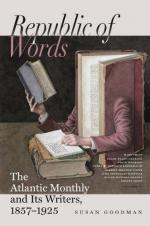While this was going on, we hired a dilapidated barouche, driven by an odd young native, neither boy nor man, “as a codling when ’tis almost an apple,” who said wery for very, simple and sincere, who smiled faintly at our pleasantries, always with a certain reserve of suspicion, and a gleam of the shrewdness that all men get who live in the atmosphere of horses. He drove us round by the Capitol grounds, white with tents, which were disgraced in my eyes by unsoldierly scrawls in huge letters, thus: THE SEVEN BLOOMSBURY BROTHERS, DEVIL’S HOLE, and similar inscriptions. Then to the Beacon Street of Harrisburg, which looks upon the Susquehanna instead of the Common, and shows a long front of handsome houses with fair gardens. The river is pretty nearly a mile across here, but very shallow now. The codling told us that a Rebel spy had been caught trying its fords a little while ago, and was now at Camp Curtin with a heavy ball chained to his leg,—a popular story, but a lie, Dr. Wilson said. A little farther along we came to the barkless stump of the tree to which Mr. Harris, the Cecrops of the city named after him, was tied by the Indians for some unpleasant operation of scalping or roasting, when he was rescued by friendly savages, who paddled across the stream to save him. Our youngling pointed out a very respectable-looking stone house as having been “built by the Indians” about those times. Guides have queer notions occasionally.
I was at Niagara just when Dr. Rae arrived there with his companions and dogs and things from his Arctic search after the lost navigator.
“Who are those?” I said to my conductor.
“Them?” he answered. “Them’s the men that’s been out West, out to Michig’n, aft’ Sir Ben Franklin.”
Of the other sights of Harrisburg the Brant House or Hotel, or whatever it is called, seems most worth notice. Its facade is imposing, with a row of stately columns, high above which a broad sign impends, like a crag over the brow of a lofty precipice. The lower floor only appeared to be open to the public. Its tessellated pavement and ample courts suggested the idea of a temple where great multitudes might kneel uncrowded at their devotions; but, from appearances about the place where the altar should be, I judged, that, if one asked the officiating priest for the cup which cheers and likewise inebriates, his prayer would not be unanswered. The edifice recalled to me a similar phenomenon I had once looked upon,—the famous Caffe Pedrocchi at Padua. It was the same thing in Italy and America: a rich man builds himself a mausoleum, and calls it a place of entertainment. The fragrance of innumerable libations and the smoke of incense-breathing cigars and pipes shall ascend day and night through the arches of his funeral monument. What are the poor dips which flare and flicker on the crowns of spikes that stand at the corners of St. Genevieve’s filigree-cased sarcophagus to this perpetual offering of sacrifice?




